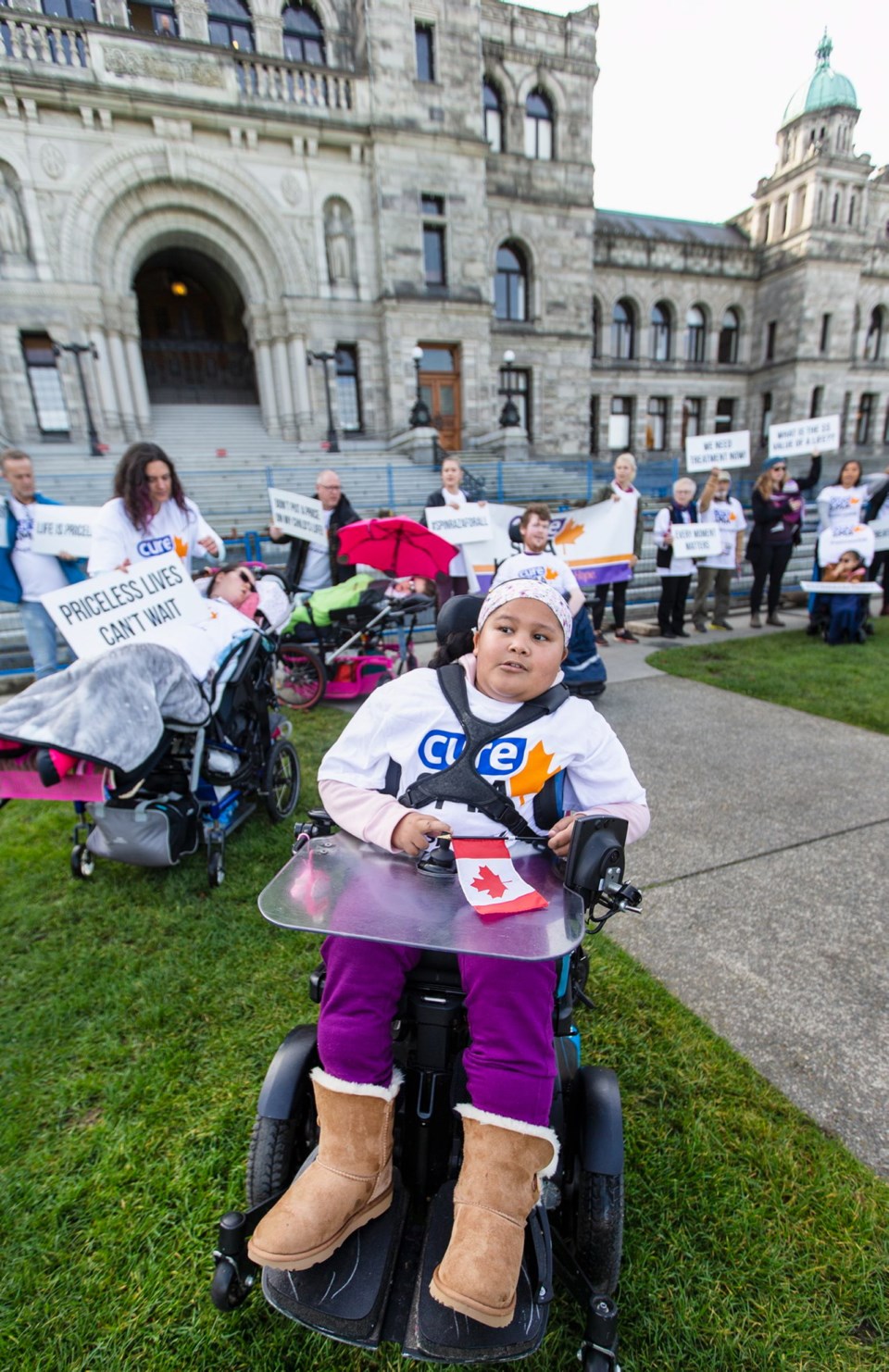Patients with spinal muscular atrophy rallied at the legislature in Victoria on Tuesday, demanding wider access to the first drug to slow or even reverse the rare, progressively debilitating, genetic disease.
The injectable drug called Spinraza reportedly costs $708,000 a patient for the first year and about $350,000 each subsequent year. The price is set by the drugmaker, Biogen.
Susi Vander Wyk, executive director of the advocacy group Cure SMA and mother of a 22-year old with the disease, said about 25 patients and their family members rallied to protest limits on access to the drug. There are about 30 patients with the disease in B.C. but only half are on the drug — either through public or private insurance. The other half don’t meet the government’s criteria and are demanding coverage for the drug.
“This treatment is making massive leaps in reversing the effects of this disease,” Vander Wyk said.
“Patients can perform functions they had lost the ability to perform, like opening a jar, working longer days, stronger lung function and ability to swallow. They will live longer, stay out of the hospital and reduce caregiver and equipment needs
“We have been fighting for over two years for the ability to access this treatment,” she said, noting 43 countries and many Canadian provinces already pay for the drug. “So why is B.C. allowing patients to progress and die? How much is a life worth? Do B.C. residents really have to look at quitting jobs, leave their communities and all they know, to move to another province … to save their life?”
Vander Wyk said the list price of the drug is high, but Canadian provinces could negotiate as a group to get a lower price. The drug is available in Quebec for all patients while Alberta, Saskatchewan and Ontario provide it mostly to patients under 18.
“My daughter is in university working towards a teaching degree, struggling with declining health while her friends in Alberta, Saskatchewan, Ontario, Quebec and the Maritimes are [on the drug and] improving,” Vander Wyk said. “We all know each other and hear of the changes in abilities. There are no other treatment options.”
Meribeth Burton, a spokesperson for the Ministry of Health, said the Common Drug Review, a national process to review new drugs, recommended in 2017 that provinces cover Spinraza for patients with Type 1 or severe disease in which signs and symptoms of disease began on or before seven months of age. The best time to intervene is early, before there is an irreversible loss of motor neurons, experts say.
A year later, B.C. agreed to cover patients who fit those criteria.
Burton said in February that the Common Drug Review recommended broader coverage, adding patients who are pre-symptomatic or 12 years of age or younger with symptom onset after six months of age, and who cannot walk independently. That recommendation is still under review by B.C., she said.
In the early part of the summer, Health Minister Adrian Dix said a decision would be made very soon.
But patients are still waiting.
Spinraza and spinal muscular atrophy:
Individuals born with SMA lack certain motor neuron proteins. Spinraza is injected into the spinal fluid to boost production of the gene responsible for protein development.
SMA patients require Spinraza treatment for their whole lives. They get six doses in the first year and three in subsequent years. Each injection is usually given in a hospital.
There are three main types of SMA:
Type 1: patients show signs and symptoms at or before seven months of age and cannot sit unsupported. These patients typically have a life expectancy of two years of age. Type 1 patients represent approximately 60 per cent of diagnosed cases.
Type 2: patients show signs and symptoms between seven months and 18 months of age. Although most can sit unsupported, they usually cannot walk independently. Life expectancy is over 25 years of age and is greatly improved by aggressive supportive care.
Type 3: patients may show signs and symptoms between 18 months and 18 years. Patients can walk but declining mobility may require use of a wheelchair. Type 3 patients typically have a normal life expectancy and represent roughly 10 per cent to 20 per cent of cases.
About one in 40 people carry the SMA gene. If both parents are carriers, there is a one-in-four probability that the gene will be passed to children.
Source: B.C. Ministry of Health



